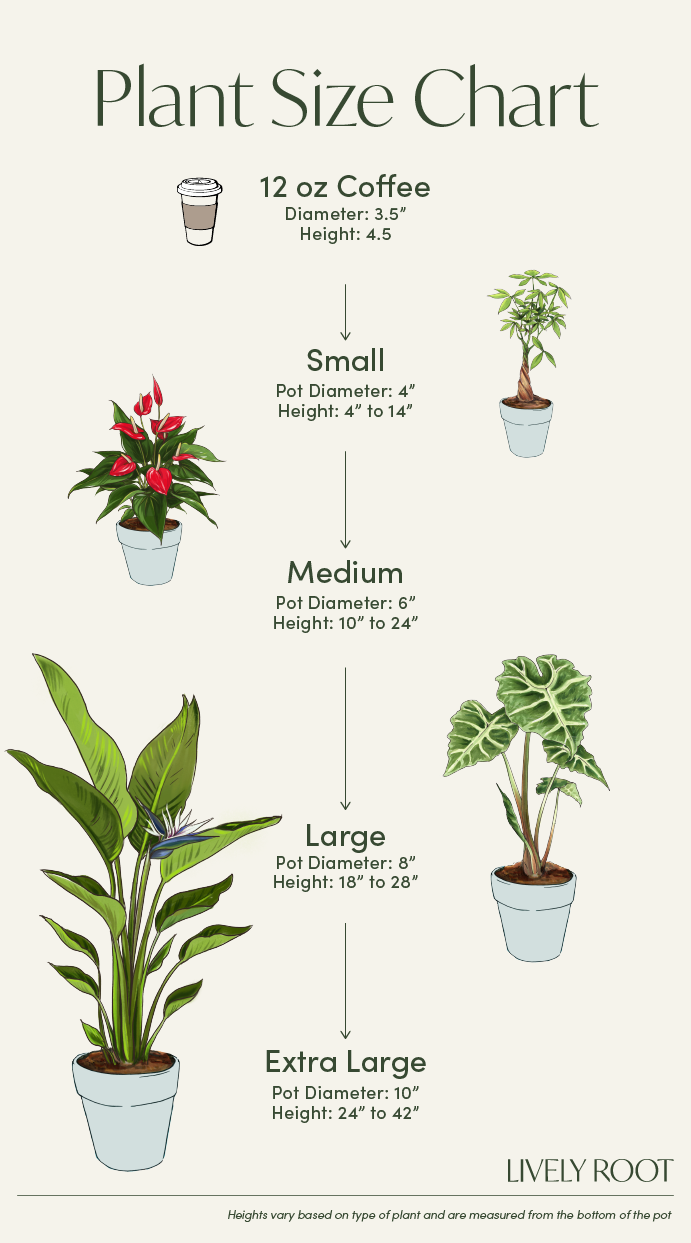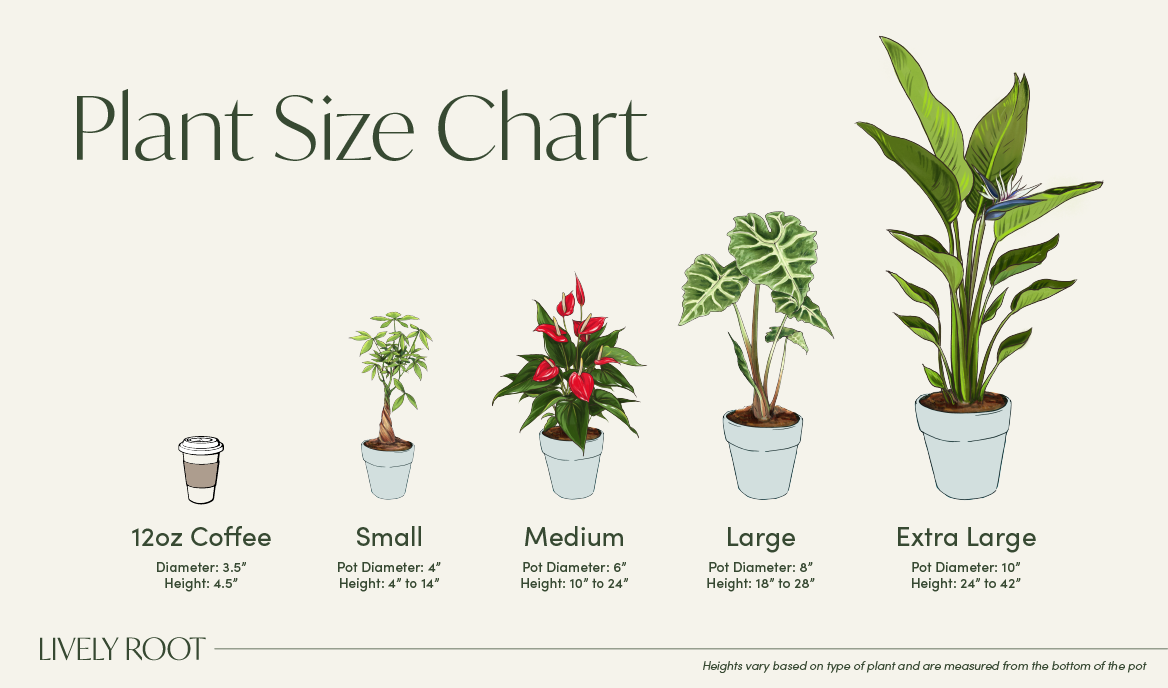

Enhance your space with the Cordyline Fruticosa Glauca, commonly known as the Green Ti or Good Luck Plant. This versatile cordyline plant, admired for its spiraling fan-like leaves and slender stalk, reaches an impressive height of 9-13 feet. Each leaf spans 12-24 inches, adding dramatic flair to any setting. As an easy plant to care for, it's perfect for both beginners and experienced plant enthusiasts.
The Cordyline Fruticosa thrives indoors as a striking house plant, adaptable to various light conditions from bright, indirect to partial shade. Its care routine is straightforward, requiring just enough water to moisten the soil. Known for its air-purifying properties, this cordyline plant is a symbol of good fortune and a healthy addition to your indoor environment.
Bring home this easy-to-care-for Green Ti and enjoy the lush, tropical ambiance it creates in your home or office.
Cordyline Fruticosa Overview & Care Guide

- Place the Good Luck plant in a shower or tub.
- Fill a watering can with a shower spout with filtered, bottled, or water free of chlorine and fluoride.
- Shower the leaves, so each one is clear of dust and dirt.
- Let the water drain and replace your plant in the decorative container.
- Dip the cuttings in water, then in a rooting hormone.
- Use a pot with drainage. and place the stem 1-2 inches down into the damp, well-draining, moist potting soil mix and tamp down around the stem securing them.
- Set it in bright, indirect sunlight while they are rooting.
- Check the moisture and humidity each day and add misting to keep the soil moist while the roots establish. After 6-8 weeks, roots will begin to establish. You can tug onto the stem to ensure the roots are secure.
Can live in medium light but performs better when exposed to bright light. Direct sun will burn leaves.
Use filtered, bottled, or tap water sitting 24 hours to release the chemicals and water enough that the water discharges out of the drainage holes. Once the water is fully drained, replace them into the cache or decorative pot. Keep the soil consistently moist but avoid overwatering as they can suffer from root rot. During winter months, reduce watering while they are in dormancy.
Enjoys high humidity. Spritz daily and add a pebble tray or humidifier to keep the humidity high.
Keep this plant in rooms where the temperature is a comfortable 75°F-80°F and avoid cold drafts below 65°F.
Outside: Keep them in shade on a patio out of direct sunlight to prevent leaf burn where nights are above 65°F.
Apply at half-strength a liquid fertilizer especially formulated with a higher nitrogen formulation ( 24-8-16 or 20-10-20 N-P-K formulation) every two month during the growing season between early spring and fall. A slow release fertilizer can be used as a top dressing instead of a liquid fertilizer.
Inside: When receiving the Good Luck plant, do not repot immediately but wait at least 6-12 months or if the roots are beginning to get crowded and growing through the drainage holes. Repot in the spring, using a 2 inches bigger pot to keep the roots drier. (Too big of a pot could cause the soil to dry slower, which is not helpful.) Place a piece of screening at the bottom of the container over the drainage hole to secure the soil and allow to drain. Use a well-draining indoor potting mix with perlite to help with drainage. Water your plant in the old pot before transferring over and let sit an hour. Add soil to the bottom to elevate the root ball. Lift the plant and release the roots against the existing planter. Use a clean knife or garden trowel to wedge between the pot and the soil to loosen. Inspect the root ball. Notice if there are any dead or rotting roots and trim off with sterile pruners. If the plant is rootbound, cut through the roots to alleviate continued encircling. Ensure the plant is sitting about 1 inch below the edge of the pot to avoid water spillage. Add more soil and backfill around the sides by tamping down. Fill up to the soil line but not over. Water thoroughly, leaving the soil damp but not soggy. If settling occurs, add more soil. Water well to dampen the soil and let drain.
Outside: Plant outside in a warm plant zone (10-12) in slightly acidic soil and keep consistently moist. Mix in compost or well-draining garden soil and root hormone to get it established. Keep in a shady part of the garden where direct light will not burn the leaves. Apply a general-purpose 20-10-20 fertilizer quarterly.
When watering your Good Luck plant, it's an excellent time to trim off any browning, yellowing, or discolored leaves. If they is getting leggy, prune back the plant to a foot above the soil. Branching will occur and encourage a bushier and fuller plant. Use these cuttings to propagate. Remove any debris from the soil and replenish if needed.
To clean debris and dust off the leaves:
In the spring or summer, take a stem cutting between 6-8 inches long with leaves attached using sanitized pruners.
Cordyline Fruticosa Glauca: Overview
Known for its vibrant foliage, the Good Luck Tree, or Cordyline terminalis, is native to Southeast Asia and the Western Pacific Ocean region. Belonging to the Asparagaceae family, this tropical plant Philodendron Vine (Philodendron hederaceum) can reach up to 6 meters high but is most often seen in pots or tubs growing to around 1-2 meters in height.
Cordyline fruticose produces panicles of fragrant small white to purple flowers in the summer, often followed by crowded bright red berries. It typically has leathery, spiky leaves in various colors, including green, red, yellow, white, purple, and purplish-red.
These popular indoor plants are beneficial for filling out difficult areas as they will tolerate a fair amount of shade throughout the day. They tend not to like full sun all day. Cordyline Glauca will bring color to your indoor and outdoor garden, but beware that it is highly toxic to dogs and cats. It is straightforward to maintain, and with proper care, it can live for several decades.
The Cordyline species has many varieties, such as Cordyline Rubra, known as Palm Lily; Cordyline Australis Red Sensation, with its red burgundy leaves; Cordyline Florida Flamingo, with its hot, deep red foliage, reminiscent of a tropical island; and more.
Cordyline Fruticosa Benefits
- It has strong air purifying properties
- It’s a low-maintenance plant, adaptable to various light conditions
- It adds a tropical vibe & an aesthetic appeal
- Has traditional medicinal & spiritual significance in Hawaiian culture
Cordyline Fruticosa Glauca Alternative Names
- Ti plant
- Hawaiian Good Luck Plant
- Cabbage Tree
- Hawaiian Ti Plant
Cordyline Fruticosa Care Guide
Cordyline fruticosa, with its moderate care requirements, brings tropical charm to your space. Follow these guidelines for optimal growth:
Watering and Light
Cordyline fruticosa plants thrive in bright, indirect light. They can tolerate a little direct sunlight, but not too much, as it can scorch their leaves. A north or east-facing window is the perfect location but keep it away from the hot afternoon sun.
It prefers slightly moist soil, so water your plant once a week or when the top inch of soil feels dry to the touch. Water thoroughly, making sure water reaches all parts of the soil.
Temperature and Humidity
These plants prefer temperatures between 60-75°F (15-24°C) but can tolerate slightly cooler temperatures. They also prefer higher humidity, ideally between 60-70%. If the air in your home is dry, you might need to mist your plant occasionally.
Soil, Repotting and Feeding
Cordyline grows well in a rich, well-drained, high-quality potting mix with a pH of 6-6.5. Repot when the plant is root-bound, typically every 2-3 years. Feed the plant with a balanced fertilizer during the growing season.
Propagation, Pruning, and Cleaning
You can quickly propagate your cordyline from stem cuttings. Prune to maintain shape remove damaged leaves, and wipe the leaves to keep the plant clean.
Common Issues
Cordyline Glauca plants are generally resistant to pests and diseases. However, they can be susceptible to mealybugs and spider mites. If you notice any signs of infestation, isolate the plant and treat it with an insecticide or neem oil.
Cordyline Ti Plant: Placement, Companion & Alternative Plants
Enhance your space with the vibrant Cordyline Ti Plant. Consider these placement and companion or alternative plant suggestions.
Best Locations & Uses
- Ideal for places with bright, indirect light; it can tolerate some shade
- Perfect as a standalone statement plant in living rooms or offices
- Suitable for beginners and those with busy lifestyles due to its easy-care nature
- Complements well with other tropical plants, creating a lively indoor oasis
- Adds a touch of exotic flair when placed on patios or balconies
Companion Plants
Pair your Cordyline Ti Plant with these delightful companions for a harmonious display:
- Philodendron Vine (Philodendron hederaceum): With its trailing vines and variegated leaves, Sweetheart Vine adds a touch of elegance and complements the Cordyline's vibrant foliage.
- ZZ Plant (Zamioculcas zamiifolia): Known for its resilience and air-purifying qualities, the ZZ Plant pairs well with Cordyline Ti, creating a balanced and visually appealing arrangement.
- Croton Petra (Codiaeum variegatum): Introduce a burst of color with Croton Petra. Its bold, variegated leaves create a dynamic contrast, enhancing the overall aesthetic of your plant arrangement.
Experiment with these companions to create a lush and inviting botanical setting in your home or garden.
Alternative Plants
If you're seeking pet-safe alternatives to the Cordyline Ti Plant, consider the following options for a worry-free green environment:
- Areca Palm (Dypsis lutescens): Known for its air-purifying qualities, the Areca Palm is non-toxic to pets and adds a touch of tropical elegance to your space.
- Spider Plant (Chlorophytum comosum): This easy-care and pet-friendly choice, the Spider Plant features arching foliage, making it a delightful addition to your indoor garden.
- Boston Fern (Nephrolepis exaltata): With its feathery fronds, the Boston Fern is a non-toxic option that thrives in humid conditions, making it a perfect alternative to the Cordyline Fruticosa plant.
Ensure a pet-friendly environment by incorporating these alternatives into your home or garden.










































